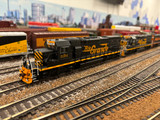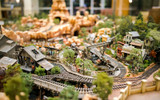5 Common Mistakes Beginner Model Railroaders Make
When you’re getting into any new hobby, there are a lot of things to learn. With model railroading, some mistakes can cause your trains to not run properly, which is a huge disappointment. Read these five common mistakes beginner model railroaders make to avoid major problems with your first layout.
Using Train Sets
Pre-packaged train sets make great starter kits for people curious about model trains, so we’re not here to bash them. However, once you decide to build your first serious layout, it’s a good idea to put your train set aside and buy new train engines, cars, and track pieces.
Train sets are often made to work on exactly the track length they come packaged with. They’re not meant to handle longer journeys like individual pieces are.
Not Understanding International Sizing Differences
Be careful when ordering train parts from manufacturers in other countries. Train sizing, which mostly relies on scale and gauge, is not uniform in every part of the world. You can get some really cool pieces by shopping overseas, but do your research to see if the scale is different.
Starting With an Advanced Layout
Model trains can be finicky. They require patience to learn all the different wiring and design elements that can impact your layout. Going straight for an ornate layout with inclines, bridges, and lifts could get you into trouble. For your first layout, try to keep things simple so you have time to learn all the techniques.
Ignoring Minimum Radius
The minimum radius for each train scale is the smallest possible space you’ll need for the train to go around a curve. If you don’t plan for this measurement, you could build a layout that your train can’t complete because you didn’t include enough space. Beginners should always give their layouts more curve distance than necessary to avoid derailing.
Forgetting To Measure Gradients
In addition to tricky curves, another mistake beginner model railroaders make is forgetting to measure their gradients carefully. Gradients are the angles of ascent and descent on ramps and slopes in your layout.
Just like real-life vehicles, model trains can only travel safely on certain gradients. Otherwise, they may stall or derail. A runaway train makes for a great movie scene, but you don’t want it tearing through your model layout!
If you’re looking for N scale locomotives to lead your next train lineup, check out our stock at Midwest Model Railroad. We carry thousands of locomotives, rolling stock, and passenger cars in various scales and gauges. We’d love to chat with you about your next project!
Recent Posts
-
Capturing History in Miniature: The Art of Prototype Modeling in the Model Railroad World
Prototype modeling in the model railroad world involves creating miniature replicas of real-life tra
-
Unveiling the Imaginative World of Fictional Railroads: Where Creativity Meets the Rails
Model railroading has long been a hobby rooted in historical accuracy and meticulous attention to de
-
Creating Your Model Railroad: Step-by-Step Guide to Laying Track
Model railroading is a fascinating hobby that allows enthusiasts to recreate miniature worlds of rai




